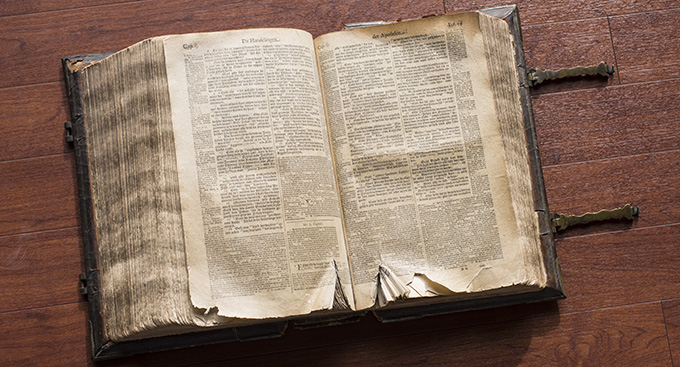Back to the Homeland
Historic Bibles from Northwestern’s collection to be displayed in Dutch exhibit
BY DUANE BEESON

DOUG BURG
This Statenbijbel, believed to have been cut by a French soldier’s saber in 1813, is one of two Dutch Bibles from Northwestern’s archives that will be exhibited at a museum in the Netherlands.
Centuries after they were transported across the Atlantic by immigrants, two Dutch Bibles will return to their homeland later this year. The volumes, among nearly 40 housed in Northwestern’s archives, will be on loan to Dordrechts Museum in the Netherlands for “Pious Patriots,” an international exhibit commemorating the 400th anniversary of the Synod of Dort.
The Bibles are Statenbijbels (States Bibles), a translation authorized by the Dutch government as an answer to England’s King James Version. The translation, first published in 1637, was requested by delegates at the Synod of Dort. Another outcome of the series of meetings in 1618 and 1619 was the Canons of Dort, which clarified five doctrines of Reformed theology in response to challenges from followers of Arminianism.
Northwestern’s collection of Statenbijbels has been donated over several decades by families with a connection to the college or northwest Iowa. Marianne Eekhout, curator of history at Dordrechts Museum, visited NWC and Dordt College last summer, seeking Statenbijbels with a special connection to the Netherlands. She was looking for Bibles that provided insight into families that immigrated to the U.S.
She settled on two from Northwestern’s archives. The oldest, published in the 1670s or earlier, was the pulpit Bible at a church in the village of Molenaarsgraaf and was donated to NWC 30 years ago by the Rev. Gerrit Maat family. It features evidence of large saber cuts believed to have been caused when Catholic French soldiers plundered and ravaged the area in 1813 during the Napoleonic era. The second, published in 1710, was chosen because of the history of the Gerrit Dirkse Schoen family recorded in the front.
Dr. Doug Anderson, professor emeritus of history and Northwestern’s archivist, says the college’s collection of Dutch Bibles is rather unusual and helps illustrate the impact made by the Statenbijbel. “The Statenbijbel fostered the creation of the modern Dutch language largely because it became a widely read text among Dutch citizens,” he says. “It also helped to spread both literacy and Protestantism. The importance of Scripture that was emphasized through the Reformation 500 years ago led to having Bibles much more readily available in homes.”
The “Pious Patriots” exhibit, which opens Nov. 10 and continues until May 2019, will focus on the lives of Calvinists in the Dutch Republic from the 17th to the 20th centuries. Among its artifacts will be several Bibles from the Dutch Royal Collection; paintings from that era, including works by Rembrandt Van Rijn and Ferdinand Bol; and silver, ceramics and glass that belonged to members of an elite Calvinist class in the Netherlands.
 A research interest that started at NWC has led to psychology professor Amanda Brouwer’s first book and offers help for those who want to get healthy and stay that way.
A research interest that started at NWC has led to psychology professor Amanda Brouwer’s first book and offers help for those who want to get healthy and stay that way. Participation in pioneering study helps Northwestern students explore careers as research scientists.
Participation in pioneering study helps Northwestern students explore careers as research scientists. Alumni share stories about the best things they found in their campus mailbox.
Alumni share stories about the best things they found in their campus mailbox. 6 Questions with Scott Simmelink
6 Questions with Scott Simmelink
Classic Comments
All comments are moderated and need approval from the moderator before they are posted. Comments that include profanity, or personal attacks, or antisocial behavior such as "spamming" or other inappropriate comments or material will be removed from the site. We will take steps to block users who violate any of our terms of use. You are fully responsible for the content that you post. Comments posted do not reflect the views or values of Northwestern College.